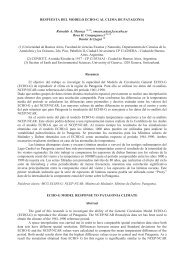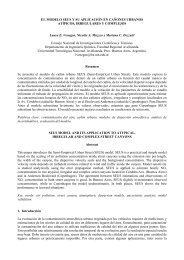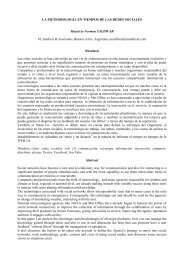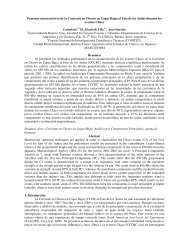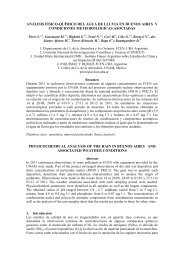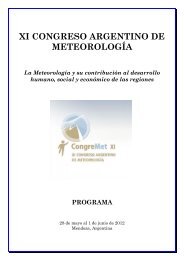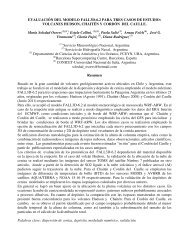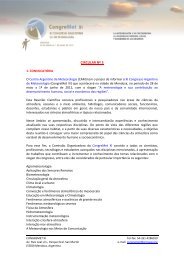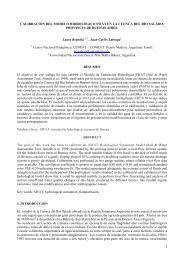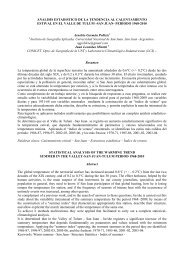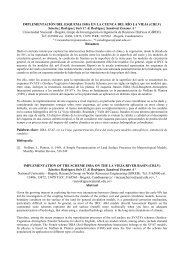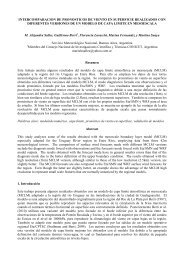influencia del tiempo y el clima sobre el tránsito y la seguridad vial
influencia del tiempo y el clima sobre el tránsito y la seguridad vial
influencia del tiempo y el clima sobre el tránsito y la seguridad vial
You also want an ePaper? Increase the reach of your titles
YUMPU automatically turns print PDFs into web optimized ePapers that Google loves.
INFLUENCIA DEL TIEMPO Y EL CLIMA SOBRE EL TRÁNSITO Y LA SEGURIDAD VIAL:SOLUCIONES TECNOLÓGICAS PARA MONITOREO METEOROLÓGICO Y MITIGACIÓN DEACCIDENTESMauricio Norman SALDIVARHéctor CHINNIBuenos Aires, Argentina, msaldivar@msaldivar.comResumenLas condiciones meteorológicas influyen de diferentes maneras a todas <strong>la</strong>s actividades realizadas por <strong>el</strong>hombre. Los patrones de tránsito, <strong>el</strong> comportamiento de los vehículos, <strong>el</strong> ánimo y <strong>la</strong>s reacciones de losconductores como también <strong>la</strong> <strong>seguridad</strong> <strong>vial</strong> no escapan a ésta premisa.El <strong>tiempo</strong> y <strong>el</strong> <strong>clima</strong> determinan matrices con variaciones ostensibles en algunos casos, imperceptibles enotros.En nuestro país son frecuentes los accidentes <strong>vial</strong>es en los cuales <strong>el</strong> factor “externo” (meteorología einfraestructura) forman parte de esa cadena de sucesos que desembocan en <strong>el</strong> siniestro.Nieb<strong>la</strong>s, nieb<strong>la</strong> y humo, viento cruzado y calzada resba<strong>la</strong>diza habitualmente se combinan con <strong>el</strong> factorhumano, y generalmente le son atribuidas en forma abrumadoramente mayoritaria <strong>la</strong>s responsabilidades aeste último factor.En este trabajo se analizan los perjuicios económicos y sociales de <strong>la</strong>s condiciones meteorológicasdesfavorables y <strong>la</strong> <strong>influencia</strong> de diferentes parámetros meteorológicos <strong>sobre</strong> <strong>el</strong> tránsito y <strong>la</strong> <strong>seguridad</strong> <strong>vial</strong>.Determinar como estas alteran <strong>el</strong> equilibrio <strong>d<strong>el</strong></strong> sistema “conductor – vehículo – vía” puede servir para haceruna conducción más segura a través de <strong>la</strong> información al conductor, de <strong>la</strong> adaptación <strong>d<strong>el</strong></strong> vehículo a <strong>la</strong>condición meteorológica presente y a <strong>la</strong> mejora y adaptación de <strong>la</strong> infraestructura a <strong>la</strong>s condicionesmeteorológicas o <strong>clima</strong>tológicas, junto con un gerenciamiento “int<strong>el</strong>igente” <strong>d<strong>el</strong></strong> flujo <strong>d<strong>el</strong></strong> tránsito.Asimismo se presentan alternativas técnicas para detectar, monitorear y advertir <strong>sobre</strong> situacionesmeteorológicas críticas para <strong>la</strong> conducción a fin para disminuir <strong>la</strong> posibilidad de accidentes; y <strong>la</strong> integraciónde dichas tecnologías como parte de sistemas ITS que permiten <strong>la</strong> toma de decisiones “on line” comotambién <strong>el</strong> registro estadístico para lograr correcciones o mejoras futuras.Esto es válido para todos los sectores involucrados: gerenciadores o responsables de <strong>seguridad</strong> <strong>vial</strong> (EntesRegu<strong>la</strong>dores, Agencias Nacionales o Provinciales, Concesionarios Viales, Organismos de Seguridad) o lospropios conductores.Pa<strong>la</strong>bras c<strong>la</strong>ve: <strong>tiempo</strong>, <strong>clima</strong>, conductor, riesgo, tránsito, ITS, monitoreo, <strong>seguridad</strong>, <strong>vial</strong>, factor,meteorológico, infraestructura, vía, accidente, siniestro, vehículo.AbstractWeather conditions affect all the human activities in different ways. Traffic patterns, vehicle behavior, moodand reactions of drivers and road safety also no exception to this premise.Weather and <strong>clima</strong>te determine matrices with obvious variations in some cases, imperceptible in others.There are frequent road accidents in our country in which the "external" factor (meteorology andinfrastructure) are part of that chain of events leading to the accident.Fog, a mix of fog and smoke, crosswinds and slippery road usually combined with human factors, andgenerally assigned to it an overwh<strong>el</strong>mingly majority of responsibilities to the <strong>la</strong>tter factor.In this paper we analyze the economic and social impact from weather and the influence of meteorologicalparameters on traffic and road safety. Finding how the weather can affect the ba<strong>la</strong>nce of "driver - vehicle -road" system can be used to make driving safer through driver information, vehicle adaptation to the presentweather conditions and the improvement and adaptation of infrastructure to weather or <strong>clima</strong>tic conditions,along with a "int<strong>el</strong>ligent" management traffic flow.It also presents alternative techniques to detect, monitor and report on weather conditions critical to driving toreduce the possibility of accidents, and integration of these technologies as part of ITS systems that allowdecision-making "on line" as w<strong>el</strong>l the stats to make corrections or improvements to come.
This applies to all sectors involved: Road Safety managers or authorities (Regu<strong>la</strong>tors, Provincial and NationalAgencies, Road Managers, Road Safety Agencies) or the drivers thems<strong>el</strong>ves.



